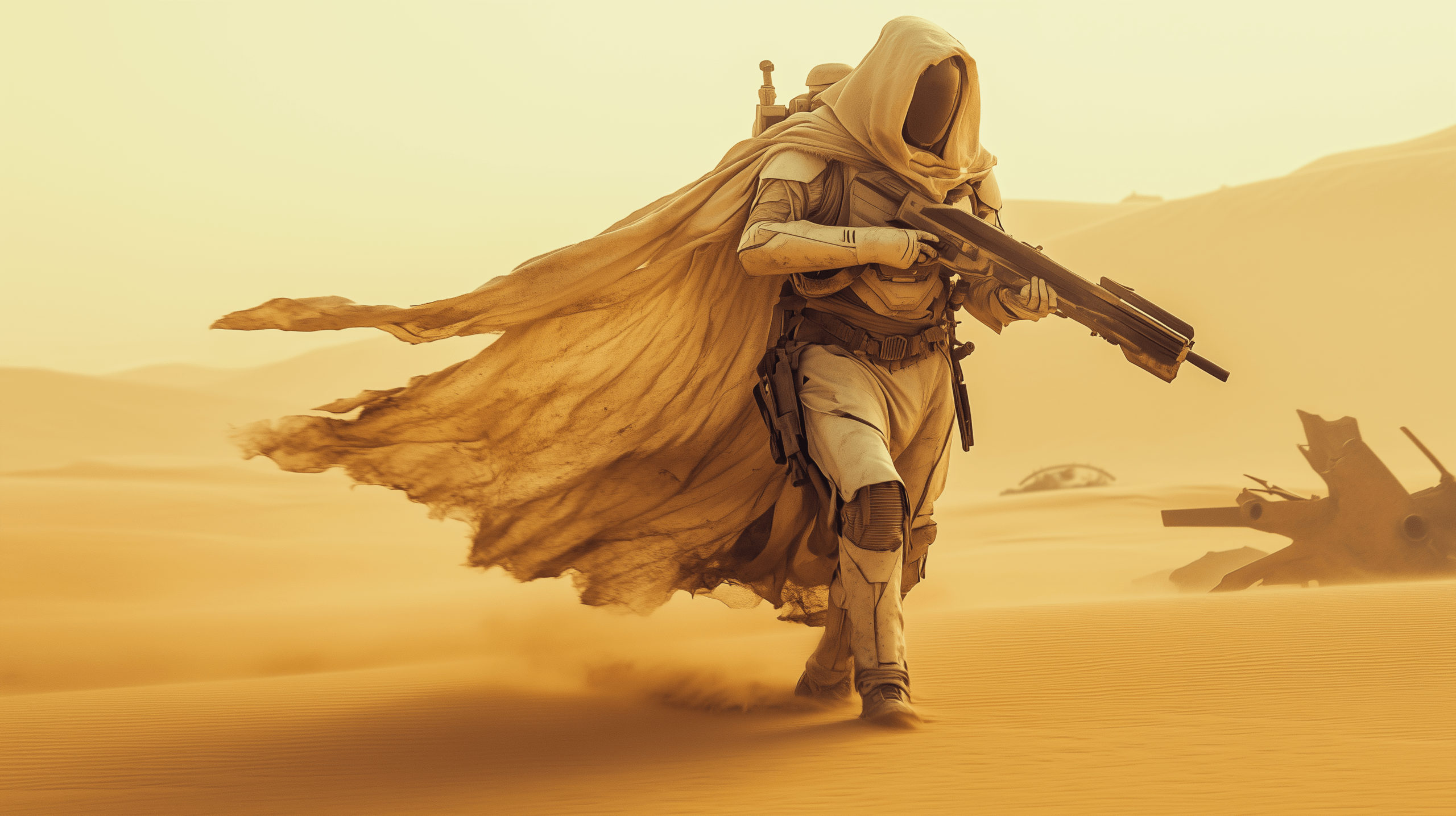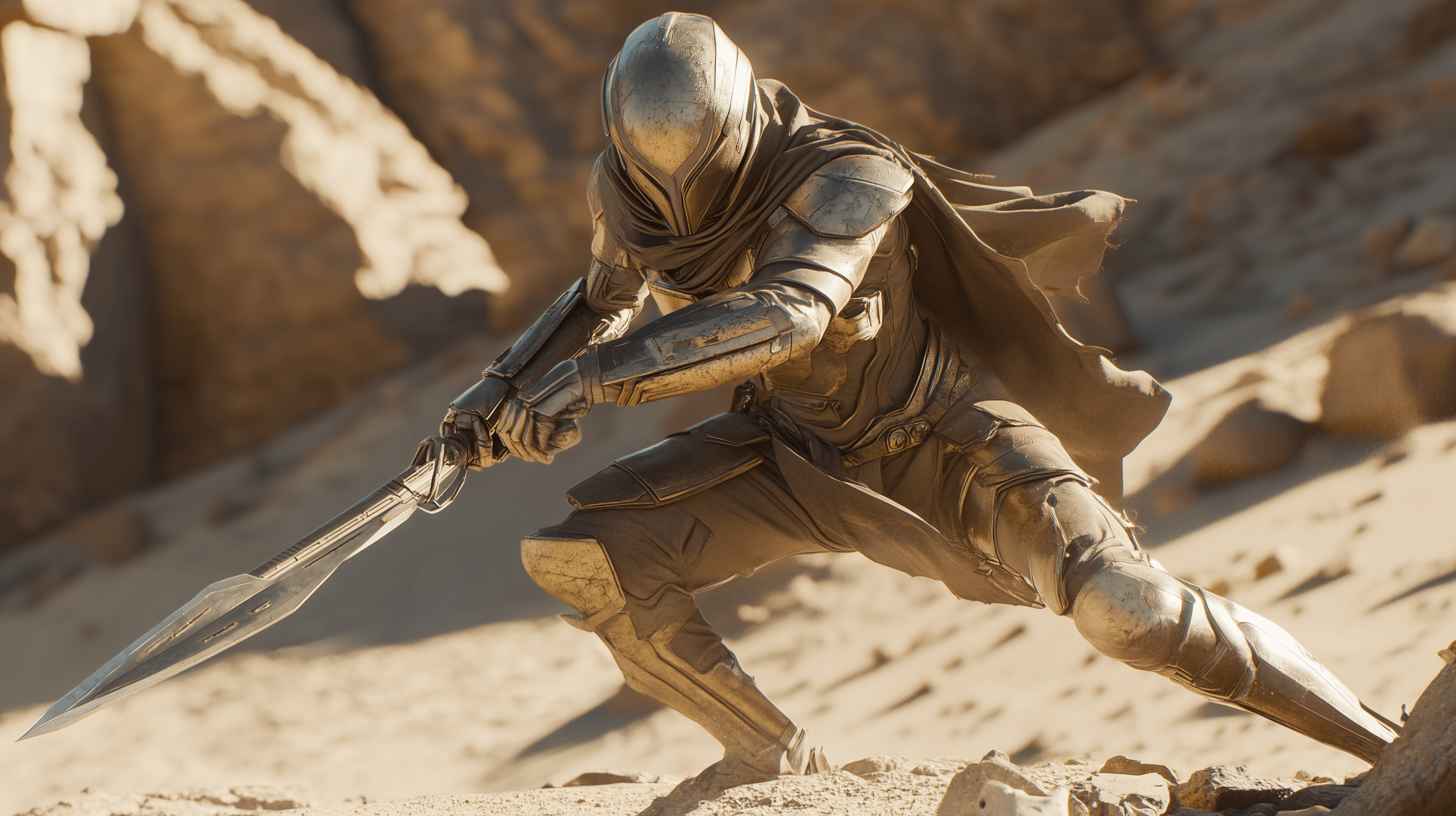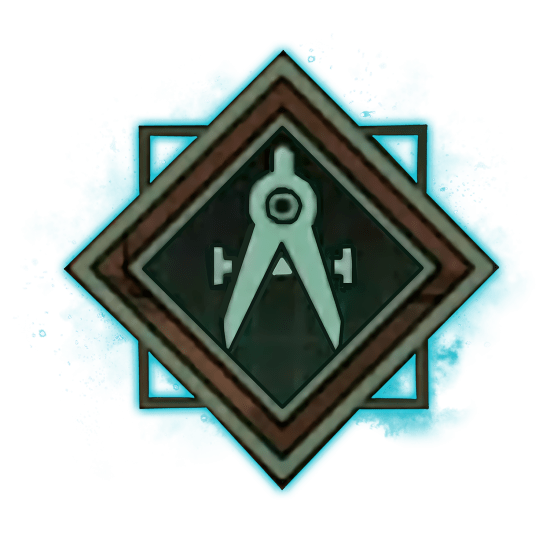Crashing onto Arrakis with nothing but a prison robe and a will to survive is only the beginning. Welcome to the Dune Awakening best builds guide, where we break down the most effective ways to survive, grow stronger, and dominate the desert.
This guide features three powerful and best builds in Dune Awakening designed for solo and PvE play—each tailored to a different stage of the game: early game, midgame, and endgame. You'll find everything you need to make each build work, including a core loadout, progression path by level, and key combat tactics.
As the game evolves, we may expand this guide with additional builds for PvP, support roles, or specialized objectives like harvesting, raiding, and sandworm hunting.
Check out other Dune Awakening guides:
Note: At Skycoach, you can Buy Dune Awakening Boost at the best prices with fast delivery. Use our special PROMO CODE (in green) hidden in this article for a 20% DISCOUNT.
Best Early Game Build – The Grenadier Nomad

This build is designed for fast, flexible, and ammo-free combat in the early game. It uses explosive tools and mobility skills from the Trooper tree to create a simple but powerful loadout that’s easy to manage and hard to stop. It’s built for solo survival, early scavenging, and rapid desert traversal—all without needing high-tier gear or rare weapons. Among early picks in the current Dune Awakening builds meta, it stands out for how quickly it comes online and how well it handles pressure.
The Grenadier Nomad is perfect for players who want to move quickly, hit hard, and rely on ability cooldowns rather than ammo reserves or melee parries. You’ll be clearing early zones with ease and building a strong foundation for more advanced hybrids later on.
Core Loadout
This loadout emphasizes cooldown-based damage, fast movement, and survival tools that let you stay in the field longer.
| Category | Recommended Choices |
| Skill Trees | Trooper (Gunnery, Tactical Tech) |
| Abilities | Explosive Grenade, Assault Seeker, Shigawire Claw |
| Techniques | Battle Hardened, Center of Mass, Suspensor Dash |
| Weapons | Dart rifle or pistol (light ammo use), knife (for shielded enemies) |
| Armor | Scout or light armor (low stamina cost, basic heat resistance) |
| Tools | Cut Array, Dew Reaper, Literjon, Heal Kit, Blood Extractor, Survey Probe Launcher |
This configuration prioritizes flexible movement and reliable ability-based damage over complex mechanics or precise aim. It’s a strong, low-maintenance setup for beginners.
Progression Path (Lv. 1–40)
From the very start, this build comes online quickly. You’ll unlock core skills in the Haga Basin and pick up important tools within the first few hours of play. BLOG20
Start by picking any class other than Trooper during character creation. Then head to the Trooper trainer, located just south of your starting position. It’s accessible immediately and requires only a basic quest to unlock the tree.
Once you have access to the Trooper skill tree, focus on unlocking the following abilities and passives:
- Explosive Grenade
- Assault Seeker
- Battle Hardened
- Center of Mass
Between level 10 and 20, add Shigawire Claw and Suspensor Dash to improve mobility. If you spot the Planetologist trainer while exploring, it’s worth picking up early for passive gathering buffs, though not essential to the build.
By level 30–40, you should have:
- Two full ability slots unlocked (grenade and seeker)
- Three key passives slotted (Battle Hardened, Center of Mass, Suspensor Dash)
- Light or scout armor equipped
- A mix of tools that support survival and exploration
This setup is strong enough to carry you into midgame zones without needing to respec or grind for elite gear.
Combat Strategy
The Grenadier Nomad thrives on quick fights and smart positioning. Open fights with your explosive grenade to damage or stagger enemies, then follow up with Assault Seeker to finish them before they get close. If enemies close the gap, either backpedal to recharge cooldowns or use a knife to deal with shielded targets. It earns its place among the Dune Awakening best PvE builds thanks to its consistency, versatility, and low dependency on gear.
Shigawire Claw gives you an escape route, helps you reach high ground, or lets you reposition behind cover in a pinch. Use it frequently—not just for traversal, but as a tactical reset during longer engagements.
Between fights, use your tools to gather resources and stay hydrated. The Dew Reaper and Blood Extractor will keep your supplies full, letting you stay in the field longer without returning to base. Survey Probe Launchers help you uncover useful points of interest early, saving time and giving you a resource advantage.
Mastering this build is about timing your abilities, controlling range, and never letting cooldowns go to waste. It’s an ideal introduction to ability-focused combat on Arrakis.
Best Midgame Build – The Blade Dancer Initiate

Built for players progressing beyond the early zones, this agile melee-focused build combines the lethal precision of the Bene Gesserit with passive durability and control skills to excel in close combat. The Blade Dancer Initiate is ideal for taking on tougher enemies solo, using high single-target burst and stagger mechanics to dismantle opponents before they can retaliate. Its focused burst potential and consistent uptime make it a strong contender for the best DPS build Dune Awakening has to offer in the midgame.
It’s a natural evolution for players who favor melee over ranged weapons and want a hands-on playstyle that rewards timing, positioning, and awareness. Though it has lower mobility than some ranged builds, its sheer damage and resilience make it perfect for sustained midgame combat.
Core Loadout
This loadout maximizes close-quarters effectiveness, balancing damage, defense, and movement tools to stay aggressive and hard to kill.
| Category | Recommended Choices |
| Skill Trees | Bene Gesserit (Weirding Way, Body Control), Swordmaster (The Blade, The Will) |
| Abilities | Prana-Bindu Strikes, Knee Charge, Foil |
| Techniques | Dance of Blades, Prana-Bindu Stability, Reckless Lunge |
| Weapons | Glutton’s Drinker (short blade), Legion Tattoo (anti-shield), Artisan Karpov 38 |
| Armor | Slaver Heavy Set or any high-armor midgame gear |
| Tools | Heal Kit, Power Pack, Dew Reaper + Literjon, Vehicle Backup Tool, Blood Extractor |
This setup uses layered damage and passive mitigation to take down enemies quickly while keeping you in the fight longer, especially when you’re engaging groups or minibosses at close range.
Progression Path (Lv. 40–100)
By the time you reach level 40, the game starts to open up with new zones, tougher enemy types, and more advanced trainers. This is where the Blade Dancer Initiate becomes a strong option, especially once you have access to key trainers for Bene Gesserit and Swordmaster skill trees.
Early in this phase, focus on unlocking:
- Prana-Bindu Strikes (main damage ability)
- Knee Charge (mobility/gap closer)
- Prana-Bindu Stability (durability)
- Dance of Blades (passive blade buff)
- Reckless Lunge (finisher and soft crowd control)
By level 60–70, you should aim to slot all three core abilities, invest in at least four passives, and begin upgrading your weapons and armor toward the Slaver Heavy set or its equivalents. Training with the Body Control and The Blade trees will further boost both your offense and resilience.
Around level 80–100, refine your passives to support your playstyle—whether it’s leaning more into damage output or survivability in large engagements. Continue unlocking tool slots as needed, and start preparing for gear upgrades using resources from tougher zones.
This stage is where the build hits its stride, offering strong 1vX potential and sustained power through most PvE zones.
Combat Strategy
The Blade Dancer Initiate rewards aggressive, deliberate play. Use Knee Charge to initiate combat and close gaps quickly, staggering your first target for an easy follow-up. Chain Prana-Bindu Strikes immediately after to burst down enemies before they can react. Foil gives you a clean finisher or stagger reset when things get chaotic. This tight, execution-focused loop is what makes it a strong candidate for a top Dune Awakening DPS build, especially for players who thrive in close-quarters combat.
Against shielded enemies, switch to your Legion Tattoo or rely on parrying to open up their defenses. Mastering parry timing is critical in this build—every successful block creates a chance to punish with heavy melee.
Use terrain and movement abilities to control the battlefield. While this build lacks ranged dominance, it excels at taking tight control of any space it enters. Your passives will absorb hits and reduce cooldowns, allowing you to stay engaged longer than most melee setups.
Healing, stamina, and water management become more demanding at this stage. Make sure to keep your Literjon, heal kits, and blood conversion tools handy during longer field runs. Combining strong timing with smart tool use lets you stay in combat longer and push into more dangerous areas without retreating.
Best Endgame Build – The Phantom Strider

This build is made for high-level players who want maximum freedom of movement, top-tier survivability, and the ability to take down anything—shielded enemies, minibosses, even full outposts—without slowing down. The Phantom Strider is a hybrid assassin-style loadout built around aerial mobility, stagger chaining, and hit-and-run melee tactics. It stands out as a Dune Awakening best solo build, especially for those who prefer to rely on skill, timing, and positioning rather than group coordination.
It’s tuned for levels 100 and beyond, when you have access to powerful belts, multiple ability slots, and the flexibility to optimize your gear and skill trees. It’s also ideal for players who want to eliminate sandworm threat by simply staying off the ground whenever possible.
Core Loadout
This build blends vertical freedom, hard-hitting melee skills, and fast skill rotations to dominate in solo PvE and open-world exploration.
| Category | Recommended Choices |
| Skill Trees | Bene Gesserit (Weirding Way, The Voice), Tactical Tech, Suspensor Training |
| Abilities | Weirding Step (teleport), Compel, Bindu Sprint |
| Techniques | Manipulate Instability, Leap Suspenser, Battle Hardened |
| Weapons | Any high-quality dagger or short blade, backup gun optional |
| Armor | Scout or Steel Suit for heat resistance and low stamina cost |
| Tools | Literjon, Dew Reaper, Heal Kit, Vehicle Backup Tool, Power Pack, Blood Extractor |
The Phantom Strider is all about flow—keeping cooldowns tight, movement continuous, and enemies constantly stunned or staggered. Gear and utility items are chosen to support extended deployment in hostile zones.
Progression Path (Lv. 100–200)
At this point in the game, you’ve unlocked all major trainers and ability slots. The Phantom Strider comes together quickly once you’ve obtained:
- Weirding Step (main teleport/stagger skill)
- Compel (stun/control tool)
- Bindu Sprint (mobility enhancer)
- Manipulate Instability (boosts stagger + follow-up damage)
- Leap Suspenser (belt passive that enables aerial control)
Start by equipping Weirding Step as your default ability—it’s low cooldown, high utility, and deals consistent damage. If you don’t have all three skill slots unlocked yet, rotate between Bindu Sprint and Compel depending on activity—exploration or combat.
Aim to slot passives like Battle Hardened for faster cooldowns and Manipulate Instability to boost your burst damage. Once you’ve found the Leap Suspenser belt, this build becomes fully operational—unlocking near-flying mobility and vertical combat engagement.
By level 150+, focus on upgrading your short blades and prioritizing scout/steel gear that reduces heat and stamina issues. High-quality power packs and a fully outfitted tool belt keep you mobile and safe for long runs across top-tier content zones.
Combat Strategy
The Phantom Strider excels by staying fast and unpredictable. Use Bindu Sprint to pick your approach vector, then Weirding Step to teleport into melee range and stagger your target. Compel locks down secondary threats or gives you space when surrounded. Its mix of mobility, burst damage, and control earns it a high spot in any Dune Awakening class builds ranking focused on solo endgame viability. BLOG20
Always play vertically—combine high ground with your Leap Suspenser belt to float between positions, escape danger, or divebomb enemies with precision. This is especially effective in outpost raids or when navigating sandworm territory. Float above the sand, engage from the air, and reset often.
Your focus is always on staggering, bursting, and retreating. The build encourages mobility over attrition. Once a target is stunned or isolated, even a basic short blade is enough to finish the job. If things get risky, rotate back to Bindu Sprint, reposition, and repeat.
You’ll chew through cooldowns fast, so passives and tool usage matter. Keep your heal kits and dew stores full, and use the blood extractor between fights to stay supplied. Combined with high endurance and tight ability windows, this build offers one of the most dynamic endgame playstyles available.
Conclusion
As you make your way across Arrakis, the build you run with can shape everything—how you fight, how you survive, and how fast you move through the game. We’ve picked out three strong builds for different points in your journey, each tuned for what matters most at that stage: early survival, midgame power spikes, and late-game efficiency.
These aren’t the only ways to play, but they’re some of the most reliable, well-rounded options you can run right now. Whether you’re clearing scavenger camps or sprinting past sandworms, there’s a setup here that’ll carry you through.
F.A.Q.
What is the best starter build in Dune Awakening?
The best starter build is the Grenadier Nomad, which uses explosive tools and mobility skills from the Trooper class. It’s simple, effective, and doesn’t rely on rare gear or ammo.
What is the best endgame build in Dune Awakening?
The Phantom Strider is the top endgame build, built around aerial movement, staggers, and melee burst. It offers unmatched mobility, survivability, and solo power.
Is a subclass necessary to make a good build in ESO?
No, subclasses aren't necessary to make a solid build in Dune Awakening. Mixing skill trees across classes is encouraged and often leads to stronger hybrid setups.
How hard is it to make the build in Dune Awakening?
Most builds are beginner-friendly and scale with level. Advanced builds require good gear and quest completions but follow clear progression paths.
What goes into a build in Dune Awakening?
A build in Dune Awakening is made up of several core components that define how your character plays:
- Skills and techniques (from different class trees)
- Weapons (melee or ranged)
- Armor sets (light, medium, or heavy)
- Belt abilities (mobility, healing, etc.)
- Tools (for healing, exploration, or resource gathering)
- Passives and upgrades (for stamina, cooldowns, resistances)
- Combat role (burst damage, survivability, mobility, etc.)
















